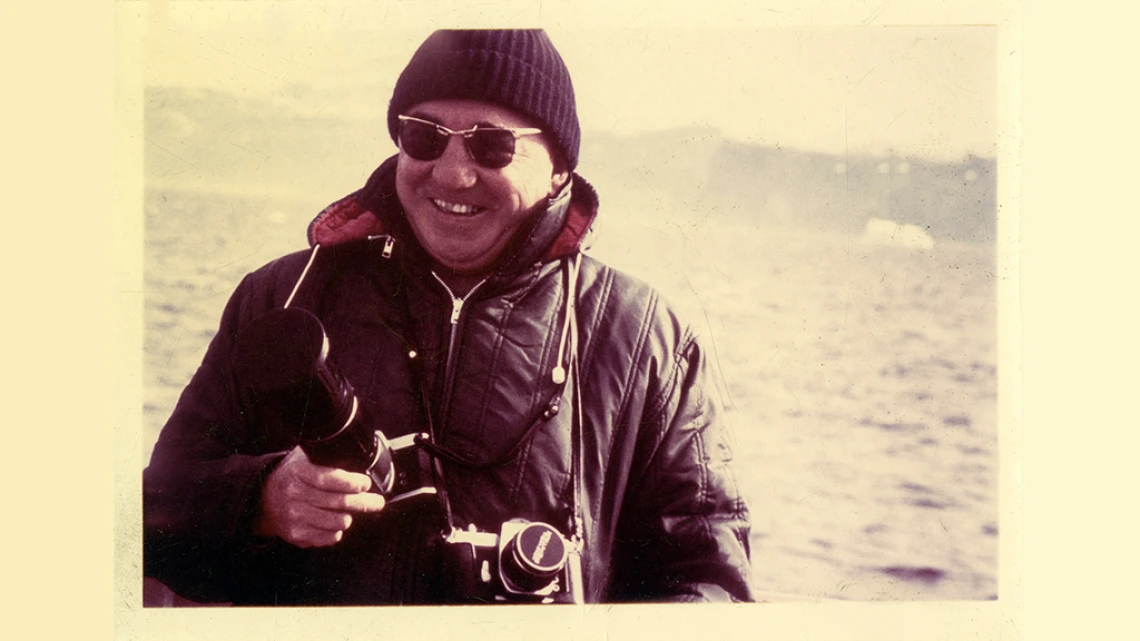Ray Vicker papers and photographs

Ray Vicker, camera in hand, in Greenland (Box 6 Folder 54).
Collection area: Literature
Collection dates: 1943-1994
Vicker, Raymond 1917-
Papers, 1939-1989, Wall Street Journal reporter and journalist. Contains travel files, correspondence, articles, books, and photographs arranged chronologically and by country.
This collection has eight series and contains papers and photographs created by Ray Vicker. Materials in this collection date from 1943-1994 and document Vicker's career as a journalist, the bulk of which was spent working as a foreign correspondent throughout Europe, Africa and the Middle East for the Wall Street Journal.
The first series contains biographical papers about Vicker that are organized at folder level including two versions of complete, month-to-month travel schedules from Vicker's life over several decades, autobiographies and articles written on Vicker, paper ephemera from political organizations Vicker supported, former schools and Vicker's hometown newspaper.
The second series, organized at folder level alphabetically by title, contains both complete and incomplete book manuscripts written by Vicker, reviews of Vicker's published books, some of his short fiction stories and a small amount of correspondence about publishing his short stories.
The third series contains both rough and final drafts of stories, clips, correspondence relating to a particular country and notes for work pertaining to the Wall Street Journal organized at folder level first by country, occasionally continent, name and then chronologically.
The fourth series contains black and white contact sheets, negatives and prints from various countries around the world photographed both for personal and professional uses and is organized at folder level by country name and entirely undated.
The fifth series contains Vicker's travel diaries and are organized at folder level chronologically. Vicker sporadically kept a diary throughout his career documenting his thoughts, personal stories and details about where he was currently working. Some years are more complete than others.
The sixth series contains correspondence, both personal and professional and written to and by Vicker, and is organized at folder level chronologically.
The sixth series contains correspondence, both personal and professional and written to and by Vicker, and is organized at folder level chronologically.
The seventh series contains official publications, newsletters, commemorative or souvenir magazines and other mass communications by either the Dow Jones Co. or the Wall Street Journal and is organized at folder level chronologically.
The eighth series contains three oversize materials. Two are biographical articles about Vicker's life and the third a "souvenir album" published by the Jerusalem Post documenting Egyptian president Anwar Sadat’s visit to Jerusalem.
Ray Vicker was born in Stevens Point, Wisconsin on August 27, 1915 according to his government-issued birth certificate, but identified his birth year throughout his life as 1917. He attended Wisconsin State University for one year from 1934-1935, worked as a news reporter at the Stevens Point Journal from 1936-1938, and then returned to school at Los Angeles City College from 1940-1941, the U.S. Maritime Service Officers School in 1944 and Northwestern University from 1947-1949.
After serving in the Merchant Marines during WWII as a seaman and ultimately as a Second Officer from 1942-1946, Vicker continued his career in journalism as the assistant shipping editor at the Chicago Journal of Commerce in 1946 and then as the automobile and trucking editor from 1947-1950. The Wall Street Journal bought out the journal in 1950 and acquired Vicker as a general assignment reporter based in the Wall Street Journal Chicago bureau until 1959.
Beginning in 1951, Vicker and his wife, Margaret, a fellow writer and photographer whom he married in 1944, regularly took lengthy 3-4 month vacations abroad, using personal time to write foreign stories to give to the Wall Street Journal to prove his interest in international reporting. In 1958, Vicker was named news editor and then in 1960, European Editor and was dispatched to the London Wall Street Journal bureau where he also frequently contributed work to the Wall Street Journal's sister publication, The National Observer. From 1960 onward, Vicker largely covered Europe, Africa and the Middle East and was named Senior International Editor of the Wall Street Journal in 1975.
During Vicker's time in the field of journalism, he won multiple awards. He received the Outstanding Reporting Abroad award from the Chicago Newspaper Guild in 1959, the E. W. Fairchild award from the Overseas Press Club in 1963 and 1967 and an honorable mention in 1965, the Bob Considine award from the Overseas Press Club and the International Capital Market Association Journalism award.
Vicker also published seven books: "How an Election was Won" (1945), "Those Swiss Money Men" (1973), "The Kingdom of Oil" (1974), "The Realms of Gold" (1975), "This Hungry World" (1975), "The Dow Jones-Irwin Guide to Retirement Planning" (1987) and "The Informed Investor" (1991) in addition to selling over 400 short fiction stories to magazines like Better Homes and Gardens, Readers Digest, Toronto Star Weekly, Thrilling Western and others.
Towards the end of 1980, Vicker returned to the U.S. as the Senior National Correspondent and worked domestically with a home base in Walnut Creek, California until his retirement on April 1, 1983 after 33 years with the paper. Even after his retirement, Vicker would still contribute occasional stories to the Wall Street Journal from his many travels both across the country and the world. In 1990, the Vickers moved to Tucson, Arizona where they lived until Ray Vicker passed away on April 19, 2000.
A collection guide explains what's in a collection. New to using our collections? Learn how to use a collection guide.
Collection guideAccess this collection
Visit us in person to access materials from this collection. Our materials are one-of-a-kind and require special care, so they can’t be checked out or taken home.
How to cite
Learn how to cite and use materials from Special Collections in your research.
